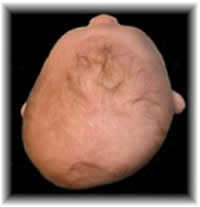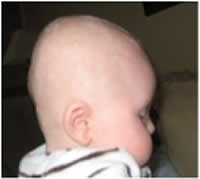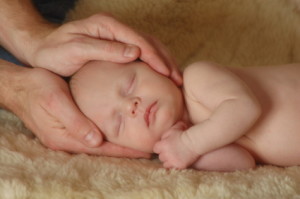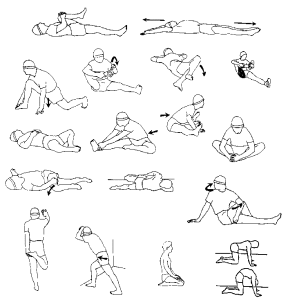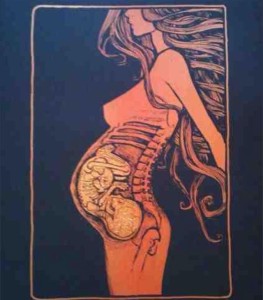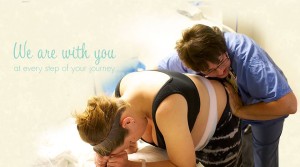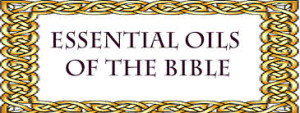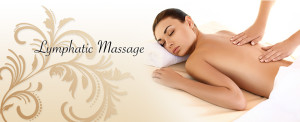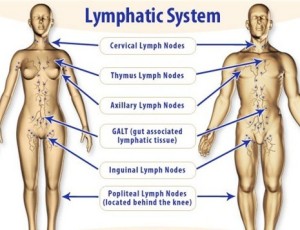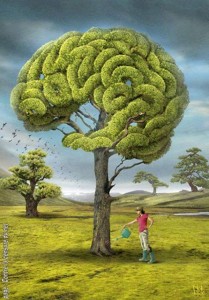Craniosacral Therapy for Plagiocephaly and Brachycephaly
Craniosacral Therapy (CST) is well known for its effective treatment of babies and children. Whilst babies are brought for treatment with a wide range of conditions, one of the more distressing for parents is severe unresolved cranial moulding. Although there are many different types of moulding patterns, one of the more common is known as plagiocephaly.
Also known as deformational plagiocephaly, positional plagiocephaly or flat-head syndrome, plagiocephaly is the medical term used to describe a flattening on one side of the back of a baby’s head.
Plagiocephalic Head Shape
This flattening is usually accompanied by a bulging on the same side of the baby’s forehead, a bald area at the flat spot as well as ear and eye misalignments. Some estimates state that plagiocephaly occurs in up to 50% of all babies under a year old to some degree.
This flattening is usually accompanied by a bulging on the same side of the baby’s forehead, a bald area at the flat spot as well as ear and eye misalignments. Some estimates state that plagiocephaly occurs in up to 50% of all babies under a year old to some degree.
Brachycephalic Head Shape
Another form of severe cranial moulding, known as brachycephaly is associated with both sides of the back of the head being completely flat. This particular moulding pattern is also associated with a head shape that is wider than it is long, and also has a high or “peaked” appearance.
This extreme moulding can occur due to the fact that at birth the bones of a baby’s skull are not fully formed and have not fused together to make the familiar sutures seen in an adult skull. As a result, they remain susceptible to the effects of external forces acting upon them.
Usually, the first port of call for worried parents is their GP or health visitor. Conventional wisdom considers plagiocephaly to be essentially a cosmetic issue, with little or no physiological consequences. Its primary cause is considered to be due to babies spending more time (especially when sleeping) on their backs as a result of the back to sleep campaign, which highlighted babies sleeping on their fronts as a significant risk factor in Sudden Infant Death Syndrome (or SIDS).
As a result, the most commonly given advice is to have more ‘tummy time’ during the day in order to reduce the pressure on the back of the head, that it will flatten out in its own time, or if not the eventual growth of the hair over the area will serve to conceal it.
Many parents feel dissatisfied with these options and so seek out alternative forms of treatment. Two of the most common treatment options that parents look into are Craniosacral Therapy (along with other practitioners offering treatment in the ‘cranial’ field e.g. cranial osteopaths, massage therapist and physical therapists) and cranial remoulding orthoses, also known as baby helmets.
Potential Side-Effects of Severe Cranial Moulding
The Institute of Child Health at the University College of London states that “There are no symptoms associated with plagiocephaly other than the flattened appearance of the back of the head – either evenly across the back or more on one side. It does not cause any pressure on your baby’s brain and development will not be affected by it in later life. Its importance is entirely cosmetic.”
Whilst this is the most commonly heard view, it is not necessarily the most accurate. We need to understand that there are both mechanical and non-mechanical forces at work with these patterns. The mechanical forces arise as a direct result of the deformation and compression of the cranial bones and sutures. These compressions can adversely affect both blood vessel and cranial nerve function with a number of significant effects. These include problems with among other things hearing, balance and co-ordination, eye movement, sucking and swallowing and even visceral dysfunction.
The non-mechanical forces include the effects of the shock that introduced the severe compressive forces in the first place. One of the most significant effects of shock is to disrupt the integrated functioning of the brain and nervous system. This combined with the mechanical factors could leave these babies at greater risk for developmental delays, motor and sensory problems and even behavioral and learning difficulties later in life.
Treatment
In order to treat the different conditions associated with severe cranial moulding effectively, we need to differentiate between treating the cause and treating the effect. The effects are the actual symptoms themselves. Chief among these is the distorted head shape, although as we have seen there may also be other associated symptoms as well.
The cause of these patterns, however, is the intense compressive forces experienced by the baby during some of his earliest experiences. These compressive forces are almost always accompanied by significant levels of shock, combined together with intense emotional content. As a result, the degree of unresolved moulding is often considered representative of the amount of unresolved shock present within the baby’s head and body.
The most common treatment approaches are as follows
- Craniosacral Therapy (CST)/ Cranial Osteopaty;
- Increased tummy timeduring the day – to take pressure off the back of the head;
- Cranial orthoses – baby helmets;
- Do nothing – assume that the remoulding process will occur on its own.
Craniosacral Therapy
Cranial therapies can be highly effective in treating not only the mechanical patterns, but also the non-mechanical forces that work together to create severe moulding patterns. However, this does not mean that all practitioners will work in the same way, and even that one practitioner is as effective as the next.
What is less well-known is that different practitioners will emphasise different aspects of the work in their practices, based upon their interests, experience and skill levels. Many practitioners are highly skilled at working with more mechanical issues, but may have little understanding or awareness of the non-mechanical forces. There tend to be fewer practitioners around who include working with the shock and emotional content of these patterns.
For effective treatment, most babies with severe cranial moulding will need to resolve the deeper emotional and shock-related issues (Information on emotional and shock: http://www.ccst.co.uk/articles.html ) before the mechanical aspects of the moulding pattern can be fully addressed. It is highly recommended that parents take the time to find a practitioner who they not only feel comfortable with, but also has experience in working in both of these ways with babies.
The content of this article came from: http://www.positivehealth.com/article/craniosacral-therapy/craniosacral-therapy-cranial-moulding-and-baby-helmets
RESOURCES TO HELP WITH CORRECTING PLAGIOCEPHALY AND BRACHYCEPHALY AT HOME:
(1) The Clinical Tortle ; www.tortle.com; average cost $24.99
(2) The Lazy Lambert; https://www.lazylambert.com/ ; average cost $19.99
(3) The Noggin Nest; http://www.boppy.com/product/boppy-head-support/ ; average cost $15.00
(4) Tummy Time Tools: http://www.choa.org/Patients-Families/New-Parents/~/media/CHOA/Documents/Services/Orthopaedics/O-and-P/Tummy-Time-Tools-update-2014.pdf
Craniosacral Therapy for Plagiocephaly and Brachycephaly Read More »

